 |
| August 22, 2017 | Volume 13 Issue 32 |
Designfax weekly eMagazine
Archives
Partners
Manufacturing Center
Product Spotlight
Modern Applications News
Metalworking Ideas For
Today's Job Shops
Tooling and Production
Strategies for large
metalworking plants
Wheels:
INFINITI reimagines the 1940s racecar -- and then builds it
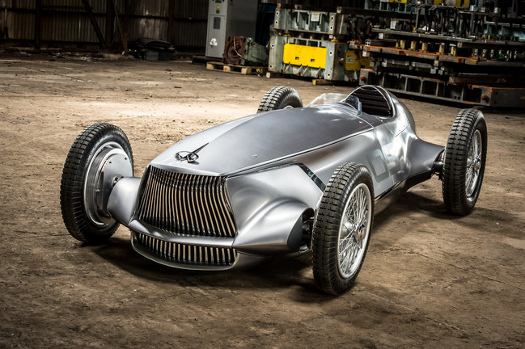
INFINITI's Prototype 9 reimagines 1940s grand prix.
Ah, if only you could take a journey back in time but carry some of today's technology with you. It's been the premise of countless sci-fi thrillers, and now it's the inspiration behind a unique electric car showcase from designers and engineers at Nissan Motor Corp. and premium automotive brand INFINITI. Together they reimagined what it would be like to build a 1940s grand prix race car using today's EV propulsion tech mixed with the hand craftsmanship of yesteryear.
They call their creation "Prototype 9."
The sleek, open-wheeled electric retro roadster was unveiled at the ritzy 2017 Pebble Beach Concours d'Elegance, the highlight of Pebble Beach Automotive Week in California, last week.
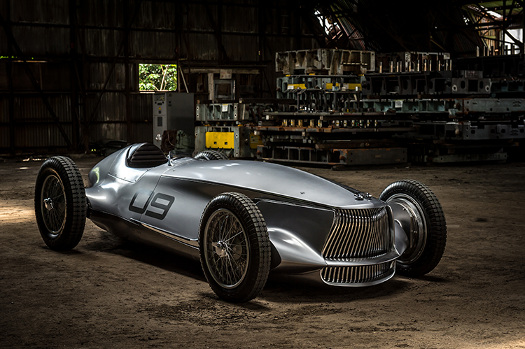
But why this car style, with this drive tech, now?
Prototype 9 was inspired by a desire to pay homage to some particularly bright spots in the history of Japanese motorsport -- and to add an imaginative design twist by going even further back in time. The real-world "winning spirit" came from the custom-built, 200-hp Prince R380, which broke several land speed records back in 1965 before taking an overall victory at the 1966 Japanese Grand Prix at Fuji Speedway. The real victory that day was that it met its main objective and beat Porsche, which was why it was built in the first place.
VIDEO: INFINITI preps to show the Prince R380 at 2017 Amelia Island Concours d'Elegance near Jacksonville, FL, earlier this year. This is the actual Japanese Grand Prix-winning car, believed to be the only surviving R380.
Prince Motor Company is considered to be Japan's original builder of premium automobiles, and its legacy can be traced to INFINITI Motor Company and its current model line. So that checks the box for one of Prototype 9's primary design cues: pedigree.
But then the designers got creative.
"We discussed the idea of 'chancing' upon an unrecognized race car, hidden away for decades in a barn, deep in the Japanese countryside," said Alfonso Albaisa, senior vice president, Global Design, INFINITI. "We wanted to explore what this looked like, what it would have been made of. Open-wheeled racers of the age were beautiful machines, elegant and powerful and with a wonderful purity of purpose. It's an automotive fantasy, but the notion captured our imaginations enough to put pencil to paper."
Prototype 9 was brought to life as an after-hours endeavor by a passionate and enterprising team of employees from across Nissan Motor Corp.
"It started as a discussion: What if INFINITI had created a race car in the 1940s?" said Albaisa. "If one were to imagine an open-wheeled INFINITI racer on the famous circuits of the era, such as Japan's Tamagawa Speedway, what would that look like? The sketches were stunning, and the idea so compelling that we had to produce a prototype. As other departments became aware of this, they volunteered their time to create a working vehicle."
The car is powered by a prototype electric motor and battery from Nissan's Advanced Powertrain Department. This nod to the future contrasts with the traditional materials and techniques applied to Prototype 9's manufacture, including panels hand-beaten by a team of Takumi -- Nissan Motor's master artisans.
"What started as an after-hours idea grew into a fully fledged prototype," said Roland Krueger, chairman and global president, INFINITI. "Our designers and engineers were excited by the notion of creating a past vision, a nod to our origins. They volunteered their own time; more and more staff became involved."
And the name? Where existing and future INFINITI models adhere to the company's "Q" and "QX" nomenclature, Prototype 9 represents something different. Echoing the company's origins, the figure "9" is pronounced "kyuu" in Japanese -- similar to the English pronunciation of the letter "Q," which is used for all of the company's production cars.
The starting point for bringing Prototype 9 to life was a conceptual sketch: an interpretation of an INFINITI race car inspired by roadsters and aircraft of the era yet molded in new materials and advanced technology. From this moment, Prototype 9's transformation from sketch to reality was inevitable.
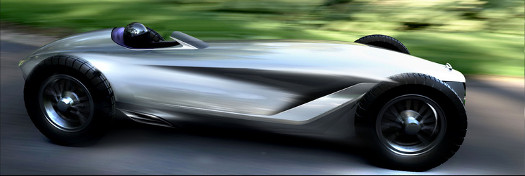
Preliminary sketch.
Albaisa created a sketch of the vehicle, with sleek lines and aeronautically inspired bodywork crafted in bare sheet metal. Initially shared only with close colleagues, the idea soon spread among INFINITI's design team members, with a number enthusiastically calling for the vehicle to be brought to life. The sketch triggered a domino effect; each person who saw it felt it deserved more attention, and soon there was a burgeoning desire within INFINITI to take it beyond the drawing board.
The vehicle was transformed from a daring idea into scale design studies in clay. Full-size models were soon formed. Although still a secretive "passion project" at this point, word spread to other parts of INFINITI and throughout its parent company. People noticed something a little different was taking shape at the design center.
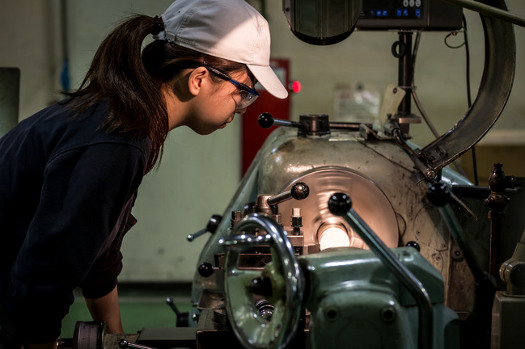
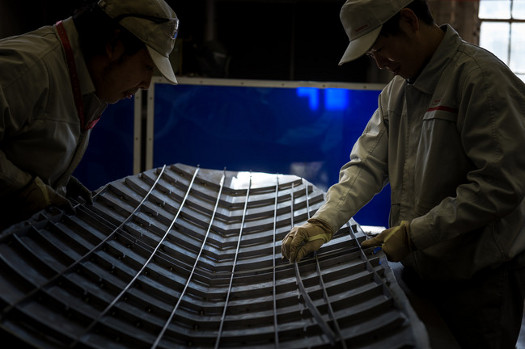
Finished in a bare sheet-metal skin, Prototype 9 is the result of countless hours of careful construction. The designs of the brand's contemporary road cars are characterized by deep-stamping production methods, which enable the creation of sharply defined lines and smooth body surfaces. Far from production lines, this out-of-hours project required similarly technical yet more traditional crafting methods.
The vehicle's stunning bodywork is made from steel body panels wrapped around a steel ladder frame. The panels were hammered into shape by the Takumi. For Prototype 9, panel beaters incorporated INFINITI's signature design elements, such as the double-arch grille, "shark gills" aft of the front wheels, a single-crease hood, and sharp lines that stretch from front to rear.
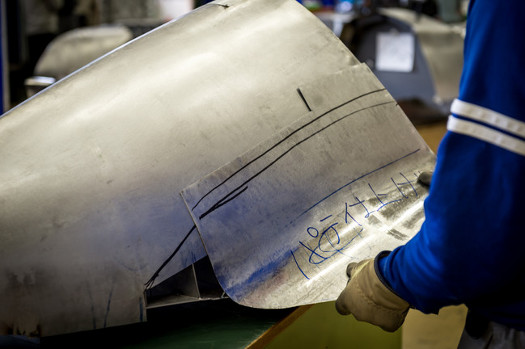
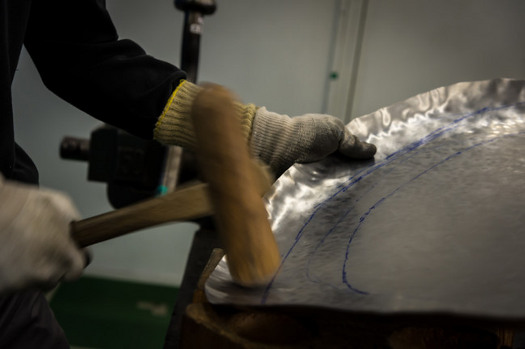
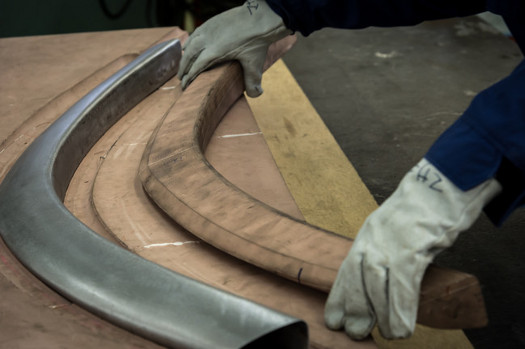
In every other respect, the car is unashamedly inspired by retro aeronautical designs. Prototype 9 is defined by its smooth, aerodynamic surfaces, long bonnet and short overhangs, an exposed cockpit, and open-wheeled layout. Nineteen-inch center-locking wire-spoke wheels at each corner are even wrapped in period cross-ply competition tires.
The intimate and focused cockpit is the result of two Japanese approaches to craftsmanship: "mitate" (pronounced "mee-ta-teh") and "shitate" ("shee-ta-teh"). "Mitate" relates to the practice of curating and bringing together the best possible selection of materials. "Shitate" is the desire to tailor the chosen combination of materials, bringing out their best characteristics.
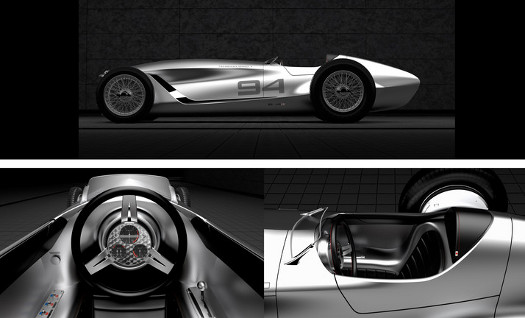
Preliminary sketches.
With this fine attention to detail and finish, the cockpit is wrapped in black leather with contrast red stitching, sewn and finished in such a way as to echo earlier single-seater racers. Subtle Japanese flags are stitched into the integrated headrests of the deep single-bucket seat.
In the cabin, the steering wheel rotates around a fixed central hub that houses the driver's instrument gauges. The hub itself is finished in turned aluminum, an effect found on aircraft throughout the first half of the 20th century. As on the machines that inspired Prototype 9's design, the effect has been completed by hand, "turning" aluminum shavings into the fascia with the end of a cork. Inspired by the project, this was a finish that the interiors team had not previously had the opportunity to explore.
With a single-minded focus on driving, the cabin features minimal switchgear modeled on cockpit switches.
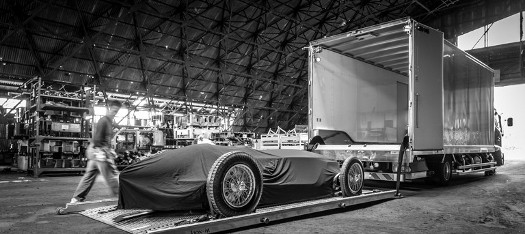
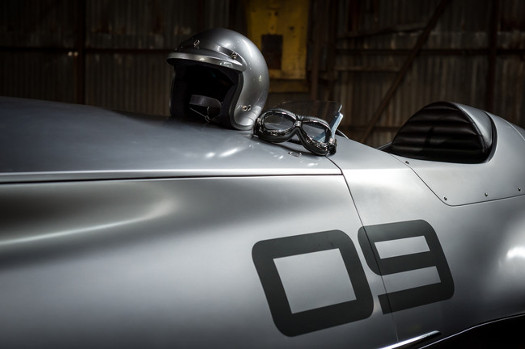
Nissan's Advanced Powertrain Department handles the prototype electric motor
While the essence of the INFINITI Prototype 9 is rooted in the past, it runs on a powertrain that looks squarely to the future.
As word of the project reached across Nissan Motor Corp., a team of powertrain engineers brought their own proposal: to equip the car with a next-gen EV powertrain -- a 30-kWh high-voltage battery paired with a prototype electric motor, one not yet seen on a production vehicle.
The motor produces 120 kW (148 hp) and 320 Nm (236 lb-ft) of torque, and it drives the rear wheels via a single-speed transmission. Prototype 9 has a top speed of 105.6 mph and sprints from 0 to 62 mph in 5.5 seconds, with a maximum EV range of 20 minutes under heavy track use.
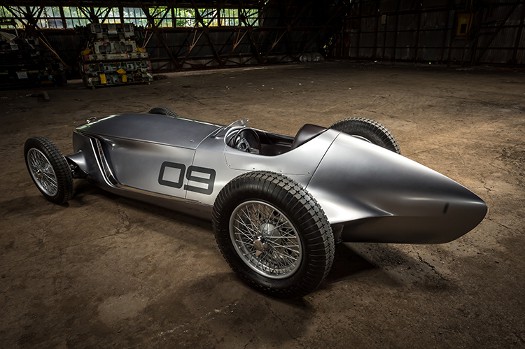
Performance-wise, we have to admit that this "racer" is really a sheep in wolf's clothing. Of course we expected Flash Gordon-inspired rocket-like propulsion! But then again, the fastest car in the world at the end of the 1940s was the Jaguar XK120 at 132 mph.
Prototype 9 is more about style and inspiration, craftsmanship and heritage in an instant-gratification, 3D-printed world, and testing elements of an "everday" EV propulsion system. And it's about the infectious delight of creating and seeing a hotrod that is so cool.
But wow, what a project! Can you imagine working on this?
Edited by Mike Foley, Editor, Designfax
Source: INFINITI
Published August 2017
Rate this article
View our terms of use and privacy policy
